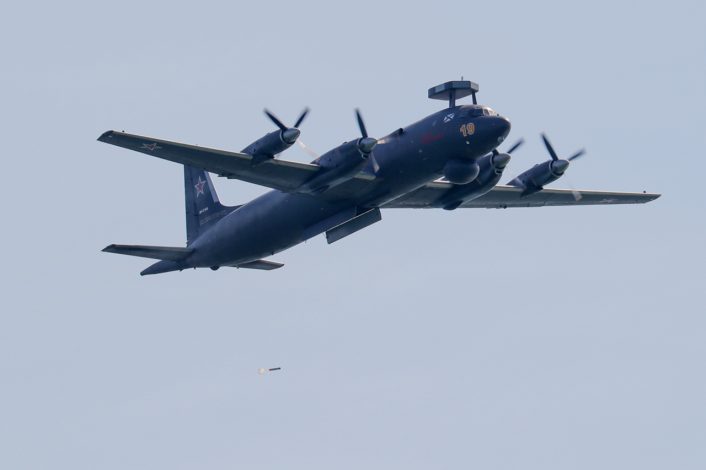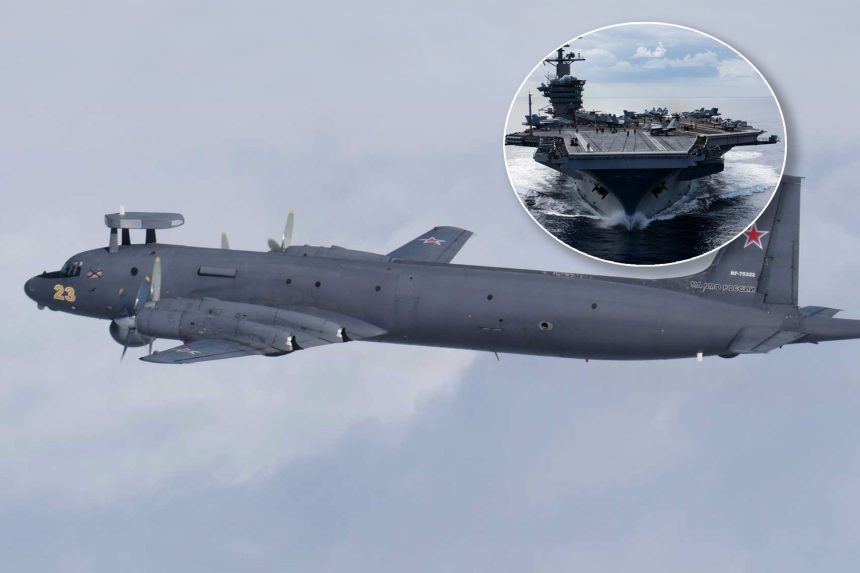Video footage emerged showing an apparently recent close encounter between U.S. and Russian forces in the Pacific Ocean.
The video shows a Russian Navy Il-38N, NATO reporting name ‘May’, flying very close by the USS Carl Vinson (CVN 70) at low level. The aircraft is accompanied by an F/A-18 Super Hornet and F-35C Lightning II, both from the carrier.
Originally posted on Instagram by user @ryans_warbirds, the video soon attracted attention and was shared across to X/Twitter and Bluesky. It appears the Instagram user in question is serving aboard the Vinson, although it is unclear if he took the video himself.
View this post on Instagram
The Il-38N is an upgraded variant of the Ilyushin Il-38 maritime patrol aircraft which entered service with the Soviet Navy in 1967. It is roughly comparable in role and age to the American Lockheed P-3 Orion, although it was built in far fewer numbers. Il-38Ns are easily distinguished by the presence of an odd-looking apparatus mounted above the cockpit which is part of the Novella P-38 surveillance suite.
Though now on their way to the U.S. Central Command area of responsibility, the Vinson Carrier Strike Group (CSG) has spent the past several weeks operating in the Pacific region near Japan. This area is a common operating area for Russian intelligence, surveillance, and reconnaissance aircraft, which are regularly intercepted by Japanese fighters.
Vinson visited Busan, South Korea in early March and now is in port in Guam. The USS Nimitz (CVN 68), which departed on Mar. 21, 2025 for its final deployment before decommissioning, will assume Vinson’s position in Asia.
Il-38N Bort No. “27” Yellow (RF-75320). https://t.co/oQVhitb0Zb pic.twitter.com/xBNRV89iOU
— Guy Plopsky (@GuyPlopsky) March 26, 2025
In the comments on Instagram, the poster of the video claims that Russian aircraft had been buzzing the carrier “all week”. Carrier groups offer a prime opportunity for intelligence gathering missions, so it is not surprising to hear of this activity – it is far from the first such occurrence.
While ships sail in international waters it is difficult to prevent foreign aircraft from making close approaches such as this as the U.S. has no legal jurisdiction to prohibit the airspace, only warn aircraft away for safety reasons. Obviously, in combat situations, if an aircraft is considered a hostile threat, they can be engaged many hundreds of miles from the carrier either by alert fighters or by anti-air missiles launched by an escorting ship.
Escort fighters will often be dispatched to monitor the foreign presence (gathering their own intelligence in the process) and, to a degree, signal that the ships are defended.
A Russian-language Telegram post on Mar. 18 seemingly spoke of the same event, saying Il-38 aircraft of the Pacific Fleet were conducting combat training over the Sea of Japan. Intercepts were apparently made by Japanese and South Korean aircraft in addition to those from the U.S. Navy.
U.S. Navy F-35C 5th-gen figher jet flies alongside a Russian Ilyushin Il-38N anti-submarine plane at low altitude as the USS Carl Vinson (CVN 70) aircraft carrier can be seen below.
Russian POV.
From the recent encounter in the Pacific Ocean. pic.twitter.com/dFujo4JBe8
— Status-6 (Military & Conflict News) (BlueSky too) (@Archer83Able) March 28, 2025
For operational security (OPSEC) reasons, footage taken by sailors aboard vessels like this is not usually considered appropriate for public release, particularly via social media, and crew members have previously been reprimanded for flaunting this. It is unknown whether the individual who recorded this video was given the all clear to post it.
In fact, in many situations where foreign intelligence assets are known to be nearby, ships will frequently enter a strict emissions control (EMCON) state where all but necessary communications will be silenced or restricted to wired systems. This can include the total prohibition of personal electronic device use on board the ship.
The setting up of unauthorized internet access on board U.S. Navy ships is a known problem. With satellite internet systems such as Starlink now commercially available and easy to use, it is one that likely will only grow.
Undersea Warriors
The Il-38N, which is equipped with a magnetic anomaly detector (MAD) and sonobuoys for the anti-submarine warfare (ASW) role, may have been most interested in the U.S. Navy attack submarine that is almost certainly shadowing the Vinson CSG. Though some obfuscation is still possible, the surface vessels in the group are fairly simple to track using satellite imagery.

Submarines are, of course, a very different story, and hunting submarines is a task that draws significant amounts of time and money for this reason. One of the most important aspects of ASW is building and maintaining a catalogue of sonar signatures for every single type and example of an adversary’s vessels.
In the event that peacetime turns to war, these collections of signatures would be vital in helping to quickly identify what is and what is not a potential threat. Sonar signatures being monitored in real time can be compared with those recorded from previous intelligence-gathering missions for threat classification.









